Figures & data
Figure 1. The earliest attempts at visualizing dinosaur relationships using a branching tree from Nopcsa (Citation1901). A, Nopcsa’s reconstruction of the internal relationships of Ornithischia; B, Nopcsa’s reconstruction of the internal relationships of Theropoda; and C, Nopsca’s reconstruction of the phylogenetic relationships of dinosaurs and birds.

Figure 2. The ’Ornithoscelida’ hypothesis represented as both a time-scaled phylogeny based on the tree from Baron et al. (Citation2017a) (A) and as a simplified topology highlighting the relationships between major clades (B). Major clades represented by silhouettes are: Silesauridae (pink), Sauropodomorpha (blue), Ornithischia (green), and Theropoda (orange). Silhouettes sourced from phylopic.org: Asilisaurus kongwe by Scott Hartman attribution 3.0 unported edited (pink), Riojasaurus incertus by Tasman Dixon CC0 1.0 license (blue), Scutellosaurus lawleri by Scott Hartman public domain mark 1.0 (green), and Dilophosaurus wetherilli by Tasman Dixon CC0 1.0 license (orange). Time-scaled phylogeny generated using the R package strap (Bell & Lloyd, Citation2015).
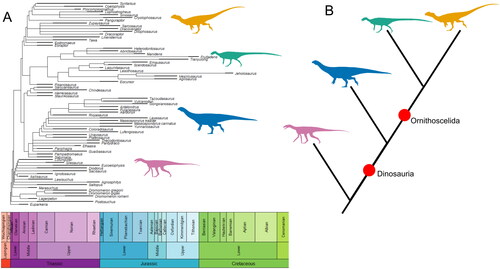
Figure 3. The ’traditional’ hypothesis represented as both a time-scaled phylogeny based on the tree from Langer et al. (Citation2017) (A) and as a simplified topology highlighting the relationships between major clades (B). Major clades represented by silhouettes are: Silesauridae (pink), Sauropodomorpha (blue), Ornithischia (green), and Theropoda (orange). Silhouettes sourced from phylopic.org: Asilisaurus kongwe by Scott Hartman attribution 3.0 unported edited (pink), Riojasaurus incertus by Tasman Dixon CC0 1.0 license (blue), Scutellosaurus lawleri by Scott Hartman public domain mark 1.0 (green), and Dilophosaurus wetherilli by Tasman Dixon CC0 1.0 license (orange). Time-scaled phylogeny generated using the R package strap (Bell & Lloyd, Citation2015).
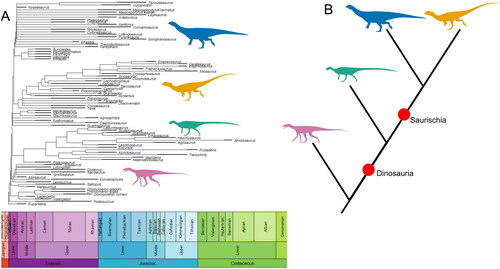
Figure 4. The ’Ornithischian silesaur’ hypothesis represented as both a time-scaled phylogeny based on the tree from Müller and Garcia (Citation2020) (A) and as a simplified topology highlighting the relationships between major clades (B). Major groups represented by silhouettes are: silesaurids (recovered as a paraphyletic grade in this analysis) (pink), Sauropodomorpha (blue), Ornithischia (green), and Theropoda (orange). Silhouettes sourced from phylopic.org: Asilisaurus kongwe by Scott Hartman attribution 3.0 unported edited (pink), Riojasaurus incertus by Tasman Dixon CC0 1.0 license (blue), Scutellosaurus lawleri by Scott Hartman public domain mark 1.0 (green), and Dilophosaurus wetherilli by Tasman Dixon CC0 1.0 license (orange). Time-scaled phylogeny generated using the R package strap (Bell & Lloyd, Citation2015).
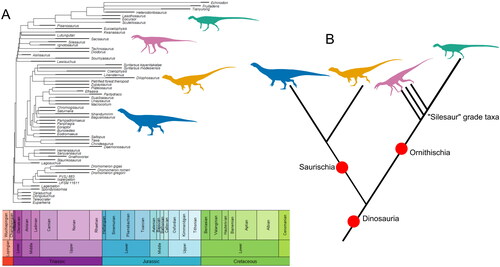
Figure 5. A phylogenetic tree of Avemetatarsalia with Pseudosuchia as an outgroup. Based on the topology from Nesbitt et al. (Citation2023). Silhouettes sourced from phylopic.org: Asilisaurus kongwe by Scott Hartman attribution 3.0 unported edited (pink), Columba by Ferran Sayol CC0 1.0 (blue), Peteinosaurus zambellii by Tasman Dixon CC0 1.0 (yellow), Ixalerpeton polesinensis by Scott Hartman attribution 3.0 unported edited (orange), Teleocrater rhadinos by Scott Hartman attribution 3.0 unported edited (blue), and Alligator missisipensis by Ferran Sayol CC0 1.0 (green).
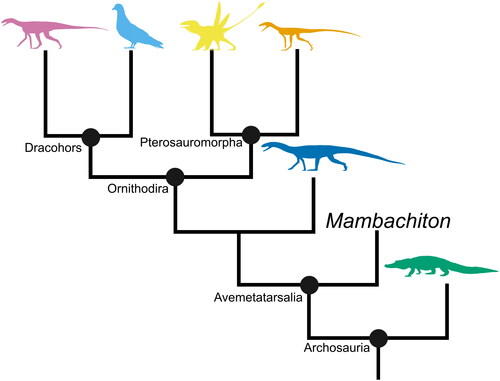
Figure 6. The current state of our understanding of dinosaur relationships visualized. A, the Ornithischia/Saurischia paradigm, the long-standing consensus about dinosaur relationships supported by dinosaur phylogenetic studies until recently. B, the paradigm is challenged, with the Ornithoscelida hypothesis of Baron et al. (Citation2017a) providing the first major challenge to the consensus. C, the paradigm collapses; an intensive period of research focussed on the problem of broad-scale dinosaur relationships creates a proliferation of competing hypotheses. Silhouettes sourced from phylopic.org: Columba by Ferran Sayol CC0 1.0 (blue), Brachiosaurus altithorax by Michael P. Taylor CC0 1.0 (yellow), Parasaurolophus walkeri by Jack Mayer Wood CC0 1.0 (green), and Asilisaurus kongwe by Scott Hartman attribution 3.0 unported edited (pink).
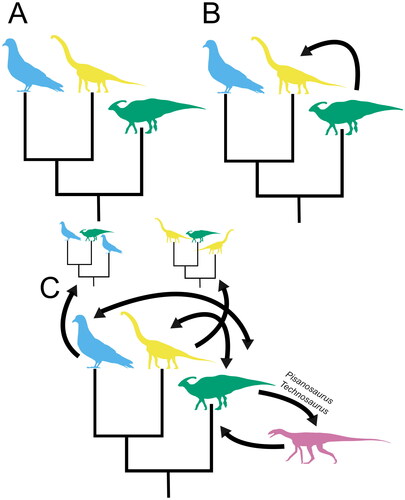
Table 1. Table modified from the one provided by Seeley (Citation1888a), in which he collated the different nomenclatures proposed for the internal dinosaur clades up to that time.
